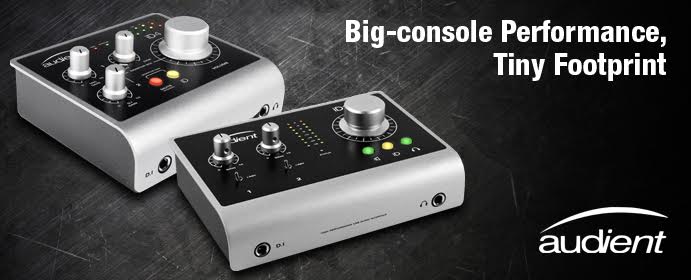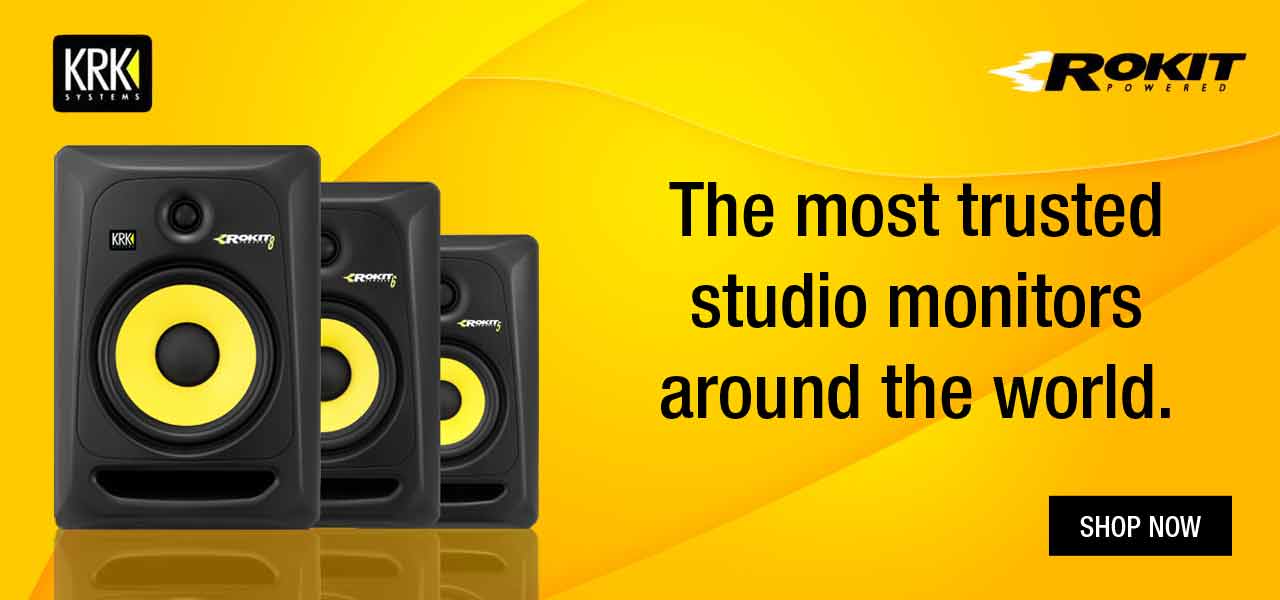There are a lot of different ways to build a home studio and if you've had a studio for a while you may already know what we are talking about. Over a period of time your studio can evolve and grow in many different directions and if you are just getting started with your setup it can be fascinating yet perplexing at the same time! There are a million products out there, all of which claim to be the savior for the studio. So wondering where do you even start? We won’t try to confuse you further by providing a never ending list of gear. Instead, we will let our in-house experts provide you with the guidance and curate a list of essential gear that you really can’t go wrong with when it comes to building your studio. Assuming you already have your basic computer and production/recording software set, let's get started with the audio interface.
1)Audio Interfaces Every PC comes with a built-in “sound card,” or audio interface which is acceptable for basic media consumption, but they are not well equipped to handle studio quality recording and playback. Your production and recording will be only as good as your interface since it’s the basic block of the studio chain which processes all the recording from the mic as well as the output to your speakers for mixing and mastering. Here are some key points you need to keep in mind while looking for an audio interface.
- Choose an interface with sufficient inputs and outputs to handle your current and future requirements. The market will be flooded with new products all the time but the basic usage and principle remain the same hence this is one piece of gear which you need not upgrade every now and then.
- Find out which interfaces is known to have good synergy with your DAW software depending on whether you are using a mac or PC.
Keeping that in mind here are some of the top choices for audio interfaces out there.  Developed by design legend David Dearden and optimized over 18 years of refinement, Audient is used by thousands of professional studios around the world. The Audient iD14 provides a pair of world-class Audient console mic pres, class-leading Burr-Brown converter technology, console style monitor control, JFET D.I and the revolutionary Scroll Control. Following from the success of the iD14, Audient proudly launched iD4 a compact and affordable audio interface, perfect for a singer,songwriters and on-the-go producers. Read more about Audient Products
Developed by design legend David Dearden and optimized over 18 years of refinement, Audient is used by thousands of professional studios around the world. The Audient iD14 provides a pair of world-class Audient console mic pres, class-leading Burr-Brown converter technology, console style monitor control, JFET D.I and the revolutionary Scroll Control. Following from the success of the iD14, Audient proudly launched iD4 a compact and affordable audio interface, perfect for a singer,songwriters and on-the-go producers. Read more about Audient Products
M-Audio and Presonus are both well-known brands trusted by musicians for decades. The M-Track interface from M-Audio® transforms your computer into a digital recording studio with plug-and-play simplicity. M-Track offers the right connections for any instrument, from an electric guitar to a professional condenser mic—phantom power is provided. The PreSonus AudioBox USB audio interface is an outstanding solution for small-format recording projects. With one Class A mic preamp and 24-bit/96kHz recording quality, you're well equipped for podcasting, vocal or instrument recordings, and electronic music production. Check out M-audio and Presonus Interfaces
2) Microphones There are basically two types of microphones – dynamic mics and condenser mics. Dynamics are typically used mainly in a live sound setting. Condensers are usually used more in recording studios. Condensers have a higher sensitive than dynamic microphones, so they pick up more detail. If you are just starting out with a tight budget and majority of your recording will be using only one microphone. You will probably want to get a good large-diaphragm condenser microphone.  Samson's C01 has all the performance features that you demand from a large diaphragm condenser microphone. It's the perfect solution for recording vocals, acoustic instruments and for use as and overhead drum mic. The C01's design includes a heavy gauge mesh grill, gold plated XLR connector and a LED for monitoring its 48V of phantom power. It also comes with a swivel mount that can be attached to any standard mic stand. Check out the Samson C01 Make sure to get a good stand and set of quality cables for your microphone or you could always go for the bundle like the one below.
Samson's C01 has all the performance features that you demand from a large diaphragm condenser microphone. It's the perfect solution for recording vocals, acoustic instruments and for use as and overhead drum mic. The C01's design includes a heavy gauge mesh grill, gold plated XLR connector and a LED for monitoring its 48V of phantom power. It also comes with a swivel mount that can be attached to any standard mic stand. Check out the Samson C01 Make sure to get a good stand and set of quality cables for your microphone or you could always go for the bundle like the one below. 
3)Headphones Whether you’re editing tracks in your room at two in the morning or recording vocal overdubs, headphones are an irreplaceable element of your home studio. You will be spending countless hours with the headphones on your head so it’s important to consider the build quality and comfort as well, along with the sound quality. Ideally for recording it’s best to go with a pair of closed monitoring headphones.  When it comes to audio quality the legendary Sennheiser Pro series consists of a no-compromise approach to sound. These monitoring headphones are designed to exceed the demands of the professional environment. The Pro series headphones provide an extended frequency response for accurate sound reproduction in demanding applications and are known for their tank-like build quality. Check out the Sennheiser HD series professional studio headphones
When it comes to audio quality the legendary Sennheiser Pro series consists of a no-compromise approach to sound. These monitoring headphones are designed to exceed the demands of the professional environment. The Pro series headphones provide an extended frequency response for accurate sound reproduction in demanding applications and are known for their tank-like build quality. Check out the Sennheiser HD series professional studio headphones  Alternatively, if you are yet to invest in an interface, microphone, and a headphone – you could save yourself the trouble by going for a complete bundle from Focusrite. This studio bundle comes with Focusrite Scarlett 2i2 -a top selling USB interface for recording studio quality audio, a pair of HP-60 closed back studio headphones and CM25 large diaphragm condenser mic for capturing crystal clear sound, with a three-metre XLR mic cable and stand clip. Everything you need to make studio-quality recordings from home. More details on the bundle
Alternatively, if you are yet to invest in an interface, microphone, and a headphone – you could save yourself the trouble by going for a complete bundle from Focusrite. This studio bundle comes with Focusrite Scarlett 2i2 -a top selling USB interface for recording studio quality audio, a pair of HP-60 closed back studio headphones and CM25 large diaphragm condenser mic for capturing crystal clear sound, with a three-metre XLR mic cable and stand clip. Everything you need to make studio-quality recordings from home. More details on the bundle
4) Studio Monitors How many times have you found your musicians friends or folks on popular recording forums and social media groups complaining about how their mixes’ final copy just doesn’t sound the same in their car or stereo. This is an issue which has caused nightmares for many sound engineers since the dawn of music production . Everybody listens to music on a different set of speaker or headphones, and no two sets of gear sound the same. So a perfectly crafted mix on one pair of speakers could sound really poor or muddy on another pair. If you have a cheap set of speakers which are not neutral sounding and if try all your tweaks to make it sound “better,” you’ll end up with a mix that sounds good only on that specific speakers and not anywhere else. What you do need is a pair of monitors that have a flat frequency response, meaning they don’t enhance or cut certain frequencies. Flat studio monitors give you a fresh slate on which you can shape your mixes to perfection. So…which monitors sound flat? You usually get what you pay for. Cheaper monitors tend to be less flat than more expensive ones but it doesn’t mean you need to spend a bomb on a pair of monitors. As long as you are not using some random multimedia speakers, you should do just fine. If you have a generous budget and a medium to a large-sized studio room , a monitor with 6-8” sized driver on it will be better suited as they can handle the bass frequencies much better than smaller sized ones. If you are on a tight budget or have a smaller sized room a 4 to 4” size driver is something you could start with.  KRK Rokits were designed to offer music professionals of all types a compact and reliable active monitor which delivered what they needed. Rokit series monitors have been an instant success and the trademark yellow driver which is found in the all standard KRK Rokit monitors can now be seen in studios, workstations, and bedrooms across the world. The 3rd generation Rokit’s start at a size of 4” driver and go all the way up to 10”. Depending on your room size, space on the desk and the budget you could choose between the Rokit 4 ,Rokit 5 for smaller space or Rokit 6 / Rokit 8 for a much fuller bass in a big room. Check-out the complete range of KRK Rokit 3rd gen
KRK Rokits were designed to offer music professionals of all types a compact and reliable active monitor which delivered what they needed. Rokit series monitors have been an instant success and the trademark yellow driver which is found in the all standard KRK Rokit monitors can now be seen in studios, workstations, and bedrooms across the world. The 3rd generation Rokit’s start at a size of 4” driver and go all the way up to 10”. Depending on your room size, space on the desk and the budget you could choose between the Rokit 4 ,Rokit 5 for smaller space or Rokit 6 / Rokit 8 for a much fuller bass in a big room. Check-out the complete range of KRK Rokit 3rd gen
5) MIDI Keyboards If you’re doing 100% recording and never need to sequence any keyboard parts or pads or synths or drum parts, then you may not need a keyboard but that’s a rare case and pretty much everyone needs a basic keyboard sequence in their song. Not everyone needs an expensive keyboard with tons of sounds. Most recording software you can get today comes with all sorts of free virtual instruments, like keyboards, strings, organs, drums, etc. Obviously, you’ll need some sort of keyboard to actually play these sounds that are packaged within your software. That’s where a MIDI controller comes in. However, the majority of musicians do need keyboards in their songs from time to time and most of them don’t have a bunch of fancy keyboards or a Steinway grand piano lying around in the corner of our studio. A MIDI interface keyboard and some virtual instrument plugins become a valuable asset in such cases. 


 Used Gear
Used Gear
 Connect
Connect




